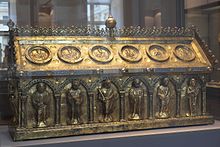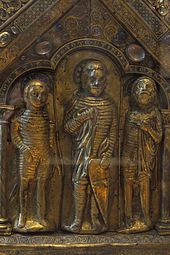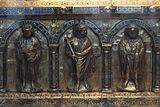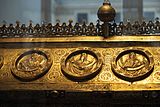Potentine Shrine
The Potentine Shrine is a reliquary that is now exhibited in the Louvre Arts and Crafts Collection ( Département des objets d'art du musée du Louvre ) in Paris . It originally comes from the church of St. Maria and Potentinus of the former Premonstratensian monastery Steinfeld in the municipality of Kall in the North Rhine-Westphalian district of Euskirchen and was created in the Trier area between 1220 and 1240 .
history
According to legend, Potentinus , a nobleman from Aquitaine , came to Trier as a pilgrim with his sons Felicius and Simplicius in the 4th century. Maximin , the bishop of Tier , sent Potentinus to Karden on the Moselle to see St. Castor , who probably also came from Aquitaine. Together they are said to have founded a monastery in Karden, in which Potentinus and his sons lived until their death.
Around 920, Count Sibodo von Hochstaden had the bones of St. Potentinus and his sons from Karden transferred to Steinfeld, where he wanted to found a Benedictine monastery . In 1097 Augustinian canons took over the monastery, and in 1138 it joined the Premonstratensians . The Premonstratensians commissioned the magnificent shrine for the saint to whom their monastery church was also dedicated.
When the Left Bank of the Rhine came under French rule during the Napoleonic Wars , Steinfeld Monastery was dissolved in 1802 and the Potentine Shrine was brought to Paris. The shrine has been kept in the Louvre since 1828.
description
The shrine is made of gilded copper. Various processing techniques that were already widespread in the Rhine-Maas region at the end of the 12th century, such as driving and filigree work , engraving and pit melting , were used. The twelve apostles are depicted on the long sides of the shrine, while medallions on the roof frame the busts of the prophets who are holding tapes in their hands. On one gable side, Jesus is depicted in the middle , surrounded by Mary and St. Augustine of Hippo ; on the other gable side, Potentinus and his sons Felicius and Simplicius can be recognized. The figures stand under arches and are framed by columns.
literature
- Explanation board in the Musée du Louvre
Web links
- Steinfeld Monastery
- Châsse de saint Potentin Musée du Louvre
Individual evidence
- ↑ The history of the monastery. 920 to 1184 Steinfeld Monastery (accessed November 13, 2016)
- ↑ The history of the monastery. 1184 to 1802 Steinfeld Monastery (accessed November 13, 2016)






